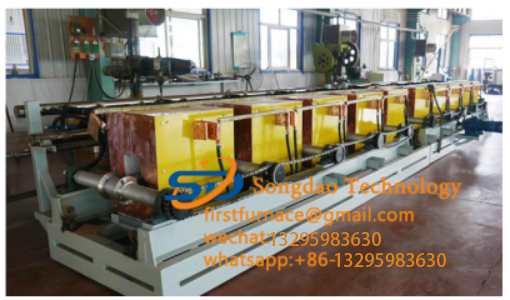- 07
- Jan
Serîlêdana pêvajoya dermankirina germê ya qutkirina alavên germkirina frekansa navîn
Serîlêdana pêvajoya dermankirina germê ya qutkirina alavên germkirina frekansa navîn
Relying on its special heating principle, the intermediate frequency heating equipment realizes environmental protection, energy saving, high efficiency and other production during the processing process. At present, it is very popular among heat treatment manufacturers in the mechanical processing industry.
Dema ku intermediate frequency heating equipment di germkirina dermankirina germê ya qutkirina metalê de tê bikar anîn, naveroka karbonê ya perçeya xebatê ya materyalên cihêreng bi giranî bi guherîna naveroka karbonê ve girêdayî ye. Dûrahiya di navbera kulika meya induksiyonê ya lihevhatî û perçeya xebatê de jî divê hinekî were sererast kirin. Rêbaza nasnameyê ya herî hêsan e ku dema ku amûra germkirina frekansa navîn dixebite, rêbaza nasîna çirûskê ya qutkirinê ye. Çirûskên perçeya xebatê li ser çerxa qirkirinê kontrol bikin. Hûn dikarin bi qasî zanibin ka naveroka karbonê ya perçeya xebatê guheriye an na. Naveroka karbonê çiqas zêde be, çirûskên wê jî zêde dibin. .
Rêbazek din a zanistî ya nasnameyê ev e ku meriv spektrometerek xwendina rasterast bikar bîne da ku pêkhateya pola nas bike. Spektrometerek nûjen-xwendina rasterast dikare di demek pir kurt de hêman û naveroka materyalê ya xebatê teftîş bike û çap bike da ku pola diyar bike. Ma ew hewcedariyên xêzkirinê pêk tîne. Ji bilî faktorên karbon-xizan an dekarburîzasyonê yên li ser rûyê perçeya xebatê, pola ku sar tê kişandin gelemperîtir e. Rûyê materyalê xwedan qatek karbon-xizan an dekarburîzekirî ye. Di vê demê de, serhişkiya rûkê kêm e, lê piştî ku 0.5 mm bi çerxek hûrkirî an pelek tê rakirin, hişkahî tê pîvandin. Tê dîtin ku serhişkiya li vê cîhê ji ya rûxara derve bilindtir e û pêdiviyan bi cih tîne, ku ev yek destnîşan dike ku li ser rûbera perçeya xebatê qatek karbon-xizan an dekarburkirî heye.
Taking the workpiece spline shaft as an example, when we use intermediate frequency heating equipment for quenching, the reasons for the uneven hardness after quenching may be as follows:
1. There may be a problem with the material of the workpiece, and the material may contain many impurities.
2. The process parameters are unreasonably determined during quenching.
3. The most likely occurrence is that the induction coil is made unreasonably, which causes the induction coil to be at different distances from the workpiece, resulting in uneven heating temperature and uneven hardness of the workpiece.
4. Kontrol bikin ka çerxa ava sarkirinê û kuna derçûna avê ya kulika inductionê xweş e, wekî din ew ê bibe sedema serhişkiya neyeksan.
When we apply intermediate frequency heating equipment to the quenching heat treatment process, we must also pay attention to a problem: the quenching heating temperature is not enough or the pre-cooling time is too long. If the quenching heating temperature is not enough or the pre-cooling time is too long, the temperature during quenching will be too low. Take medium carbon steel as an example. The quenched structure of the former contains a large amount of undissolved ferrite, and the structure of the latter is troostite or sorbite.
Furthermore, when we apply intermediate frequency heating equipment to the quenching heat treatment process, insufficient cooling is also a big problem! Especially during scanning quenching, because the spray area is too short, after the workpiece is quenched, after passing through the spray area, the heat of the core makes the surface self-tempering again (the large step of the stepped shaft is most likely to be generated when the large step is in the upper position), and the surface is self-returning. The fire temperature is too high, which can often be sensed from the surface color and temperature. In the one-time heating method, the cooling time is too short, the self-tempering temperature is too high, or the cross-sectional area of the spray hole is reduced by the scale of the spray hole, which causes the self-tempering temperature to be too high. The temperature of the quenching liquid is too high, the flow rate is reduced, the concentration changes, and the quenching liquid is mixed with oil stains. Partial blockage of the spray hole is characterized by insufficient local hardness, and the soft block area often corresponds to the blockage position of the spray hole.

